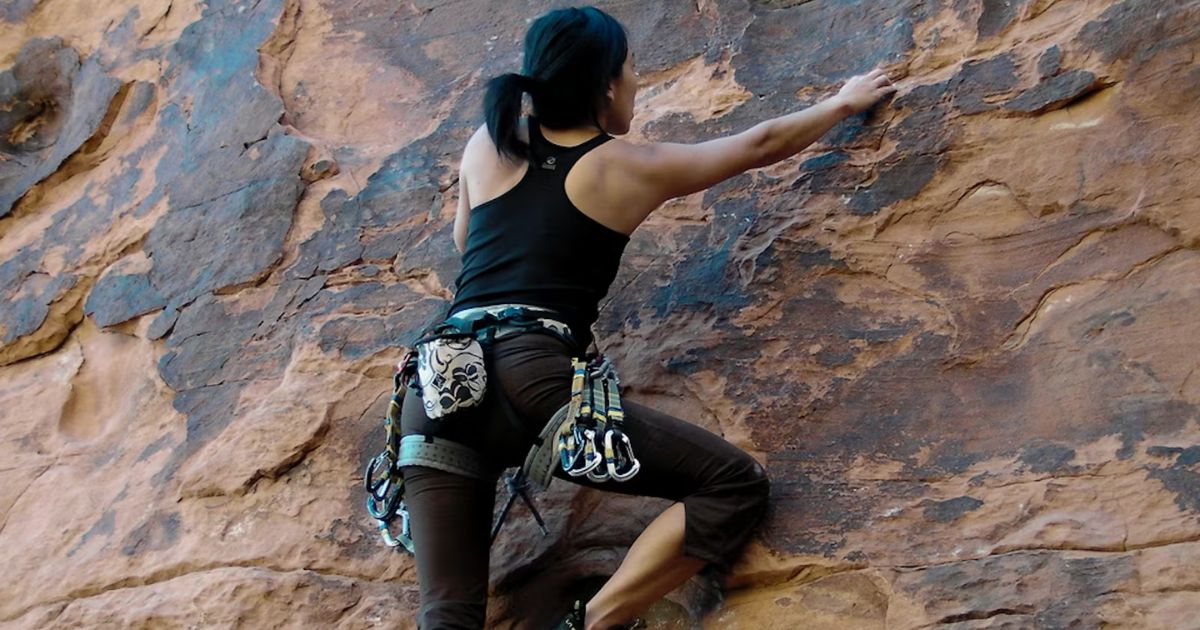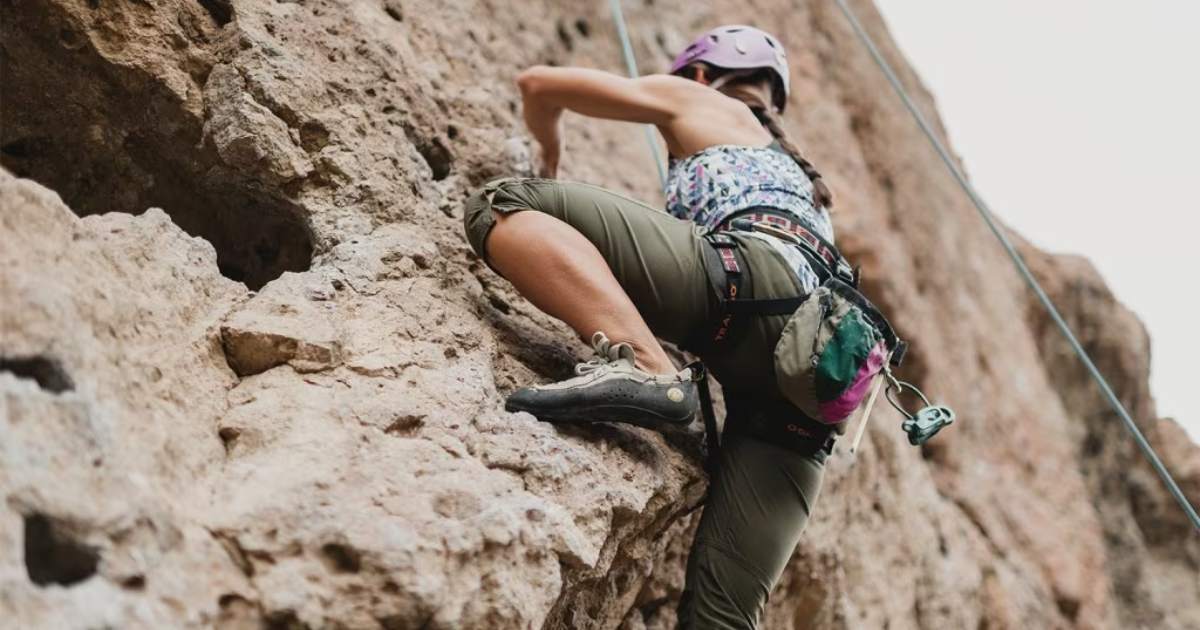Are you ready to conquer the heights and immerse yourself in the world of rock climbing? Before you embark on this thrilling adventure, it’s crucial to understand the importance of proper attire.
Your choice of clothing can greatly impact your performance and comfort level at the climbing gym. In this article, we will delve into the practical details of what to wear for maximum efficiency, safety, and style, ensuring that you feel like a true part of the climbing community.
Key Takeaways
- Prioritize comfort over style and choose stretchy and breathable materials
- Opt for loose-fitting tops and pants for ease of movement
- Select climbing shoes that provide a snug fit and have a sticky rubber sole
- Layer clothing for temperature control and choose materials that are both insulating and breathable
Importance of Comfortable Clothing
Comfortable clothing is essential for a successful and enjoyable rock climbing gym experience. When it comes to climbing gear, it is important to prioritize comfort over style. Opt for clothing that allows for a full range of motion, such as stretchy and breathable materials like spandex or moisture-wicking fabrics. Loose-fitting tops and pants that are not too restrictive will make it easier to move around and maintain flexibility while tackling challenging routes.
Comfortable shoes are crucial for rock climbing. Look for climbing-specific shoes that provide a snug fit without causing discomfort or pain. These shoes should have a sticky rubber sole that offers excellent grip on the climbing wall or holds. By wearing comfortable clothing and shoes, climbers can focus on their technique and enjoy the exhilaration of the sport. When considering what to wear to a rock climbing gym, it’s important to keep in mind the significance of comfortable shoes and clothing tailored to the activity.
Choosing the Right Climbing Shoes
When selecting appropriate footwear for rock climbing, it is crucial to carefully choose climbing shoes that provide optimal performance and fit. Here are some key factors to consider when choosing the right climbing shoes:
- Optimal shoe size: It is essential to find the right size that offers a snug fit without causing discomfort. Climbing shoes should fit tightly, but not to the point of causing pain. Consider trying on different sizes and brands to find the perfect fit for your feet.
- Choosing the right brand: Different climbing shoe brands offer various features and designs that cater to different climbing styles and preferences. Research and read reviews to find reputable brands known for their quality, durability, and performance.
- Consider your climbing style: Are you a beginner or an experienced climber? The type of climbing you do will influence the type of shoe you need. For example, bouldering shoes are designed for short, intense climbs, while trad climbing shoes provide more support for longer climbs.
Optimal Clothing Materials for Climbing
When it comes to choosing clothing materials for rock climbing, it is important to prioritize breathability and durability. Breathable fabrics, such as polyester and nylon blends, allow for airflow and moisture-wicking to keep you comfortable during intense climbs. Additionally, opting for durable materials like reinforced nylon or ripstop fabrics will ensure that your clothing can withstand the wear and tear of the climbing gym, providing longevity to your gear.
Breathable Fabrics for Comfort
One suitable choice for climbers seeking comfort and breathability during their gym sessions is to opt for clothing made from breathable fabrics. These fabrics offer a range of benefits that can enhance the overall climbing experience. Here are some of the best brands for breathable fabrics:
- Patagonia: Known for their high-quality outdoor gear, Patagonia offers a wide range of clothing made from breathable materials such as merino wool and synthetic blends.
- The North Face: This popular brand is known for its innovative and durable fabrics that provide excellent breathability and moisture-wicking properties.
- Arc’teryx: Renowned for their technical climbing gear, Arc’teryx offers clothing made from advanced fabrics like Gore-Tex and Polartec, which are highly breathable and weather-resistant.
When choosing clothing for your climbing sessions, consider these brands for their reliable performance and comfort. Investing in breathable fabrics will ensure that you stay cool, dry, and comfortable throughout your climbing adventures.
Durable Materials for Longevity
To ensure the longevity of your climbing clothing like climbing apparel, it is essential to select durable materials that can withstand the demands of the sport. When it comes to choosing the right clothing for rock climbing, durability is key. Climbing involves rigorous movements and exposure to abrasive surfaces, making it crucial to invest in durable clothing that can withstand wear and tear.
Look for clothing made from materials such as nylon or polyester, as they are known for their strength and abrasion resistance. These fabrics are designed to withstand the rough environment of rock climbing, ensuring that your gear will last for a long time. Consider clothing with reinforced stitching and reinforced knees and elbows for extra durability. By opting for durable clothing, you can enjoy your climbing adventures without having to worry about your gym climbing wear out.
Layering for Temperature Control
When it comes to rock climbing, maintaining the right body temperature is crucial for optimal performance and comfort. Layering your clothing is a key strategy for regulating your body temperature as you climb. Understanding the importance of layering and choosing the right materials can help you stay warm in cold conditions and cool in warm conditions, allowing you to focus on your climb without being distracted by discomfort.
Clothing for Changing Temps
The appropriate clothing for managing changing temperatures in a rock climbing gym is essential for ensuring comfort and performance. When it comes to dealing with changing weather conditions, proper insulation is key. Here are some tips to help you navigate the fluctuating temperatures:
- Layering: Start with a moisture-wicking base layer to keep sweat away from your body. Add a mid-layer for insulation and warmth, such as a fleece or down jacket. Finally, top it off with a waterproof and breathable outer layer to protect you from wind and rain.
- Adjustable clothing: Look for items with adjustable features like cuffs, hems, and hoods. This allows you to customize the fit and regulate your body temperature accordingly.
- Breathable fabrics: Opt for clothing made from breathable materials like merino wool or synthetic blends. These fabrics allow moisture to escape, keeping you dry and comfortable.
Importance of Layering
Layering is an essential technique for maintaining optimal comfort and temperature control while rock climbing, as it allows climbers to adapt to changing weather conditions and physical exertion levels. When it comes to layering, it is important to choose the right fabrics that offer moisture-wicking properties. Moisture-wicking fabrics help to draw sweat away from the body, keeping climbers dry and preventing them from feeling cold and clammy. Synthetic materials like polyester and nylon are great choices for base layers, as they efficiently wick away moisture.
For insulation options, climbers can opt for lightweight and breathable mid-layers made of materials like fleece or down. These provide warmth while still allowing for breathability. Finally, a weather-resistant outer layer, such as a waterproof shell, is crucial for protecting against wind, rain, and snow. By layering with moisture-wicking fabrics and suitable insulation options, climbers can stay comfortable and regulated in varying temperatures during their rock climbing adventures.
Protecting Your Skin and Hands
To effectively protect your skin and hands while rock climbing, it is essential to take proper precautions and use appropriate gear. Here are some tips to help you protect your skin and care for your hands while climbing:
- Apply sunscreen: Protect your skin from harmful UV rays by applying sunscreen with a high SPF before heading to the climbing gym.
- Wear long-sleeved shirts and pants: Covering your skin with clothing can prevent scrapes and bruises while climbing.
- Use chalk: Chalk helps to absorb sweat and moisture, providing a better grip and reducing the chances of slipping or losing control.
Taking care of your hands is equally important:
- Use hand moisturizer: Climbing can be harsh on your hands, so keep them moisturized to prevent dryness and cracks.
- Use hand salve: If your hands develop calluses or blisters, use a hand salve to soothe and protect them.
- Keep nails trimmed: Short nails reduce the risk of them getting caught or broken while climbing.
The Role of Properly Fitted Harnesses
Properly fitted harnesses play a crucial role in ensuring the safety and stability of climbers during their ascent. Harnesses are an essential piece of safety equipment that allows climbers to secure themselves to the rope, preventing falls and providing support. When choosing a harness, it’s important to consider the proper fit. A well-fitted harness should be snug but not uncomfortable, with adjustable leg loops and a waist belt that can be tightened securely.
It should also be made of durable materials that can withstand the rigors of climbing. Proper climbing techniques, such as maintaining three points of contact and using proper belay techniques, are essential for a successful climb. However, without a properly fitted harness, climbers put themselves at risk of injury. Now, let’s move on to discussing additional accessories for climbing success.
Additional Accessories for Climbing Success
When considering what to wear to a rock climbing gym, it is important to also take into account the additional accessories that can contribute to climbing success. These accessories not only enhance safety but also improve performance and comfort during your climbing sessions. Here are three essential accessories for a successful climbing experience:
- Climbing Helmet: A helmet is crucial for protecting your head from potential falling debris or accidental impacts. Look for a lightweight and well-ventilated helmet that fits securely for maximum safety.
- Climbing Gloves: Investing in a good pair of climbing gloves can provide you with a better grip and protect your hands from abrasions and blisters. Choose gloves that offer dexterity and durability without compromising your ability to feel the rock.
- Chalk Bag: A chalk bag is essential for maintaining a dry grip while climbing. It allows you to apply chalk to your hands whenever needed, enhancing your grip and reducing the risk of slipping.
FAQ’s
Are There Any Specific Clothing Items or Accessories That Can Help With Grip and Traction While Climbing?
When it comes to rock climbing, having the right clothing options and hand grip aids can greatly enhance your performance. Certain clothing materials and accessories can help improve grip and traction, ensuring a safer and more enjoyable climbing experience.
Is It Recommended to Wear a Helmet While Rock Climbing in a Gym?
When rock climbing in a gym, it is highly recommended to wear a helmet for safety reasons. Wearing a helmet provides protection against potential head injuries, ensuring a safer climbing experience.
What Type of Clothing Is Best Suited for Indoor Climbing During Warm Weather?
When considering clothing options for indoor climbing during warm weather, it is important to choose lightweight and breathable materials that allow for ease of movement. Additionally, proper climbing shoe maintenance is crucial for optimal performance and safety.
Are There Any Specific Guidelines for Wearing Jewelry or Watches While Rock Climbing?
When it comes to rock climbing, it is important to prioritize safety. Therefore, it is recommended to avoid wearing jewelry while climbing as it can pose a risk of injury. Watches, in particular, can interfere with your grip and should be removed before climbing.
How Often Should Climbing Shoes Be Replaced to Maintain Optimal Performance and Safety?
Climbing shoe maintenance is crucial for optimal performance and safety. Regularly inspect your shoes for signs of wear, such as thinning rubber, delamination, or loss of traction. Replace them when necessary to ensure the best climbing experience.
Conclusion
In conclusion, choosing the right clothing and accessories for rock climbing is essential for comfort, safety, and optimal performance. Comfortable and breathable materials, properly fitted harnesses, and protective gear for the skin and hands are all important considerations.
Layering for temperature control can help maintain comfort in varying conditions. By paying attention to these details and selecting the appropriate gear, climbers can focus on enjoying their experience and reaching new heights.











